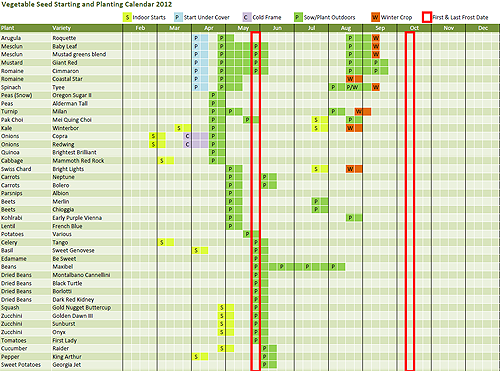The garden layout is finished, the seeds have arrived. It’s almost time to begin spring seed sowing. This year we are putting in over 50 different varieties of vegetables. Some are old favourites, many are new. Growing so many types and varieties of vegetables is a bit overwhelming so I once again created a detailed spring vegetable planting calendar.
Two new objectives for our garden this year are first to improve on succession planting so that we have a steady stream of fresh vegetables and second to extend the season as far as we can early into spring and late into winter. My 2012 spring planting calendar includes not only times to start seeds indoors but when to plant out cold season crops under cover in spring. It also calls for a large fall planting, that when covered, should allow us to harvest vegetables well into winter.
To achieve these objectives I divided my vegetables into their relative cold hardiness.
Cold Season Vegetables: These vegetables prefer cool growing temperatures and often stop growing, won’t germinate or bolt in hot weather. They are planted as early as possible. For us some will even be planted under cover in early spring. They can also be planted in mid- to late-summer for a fall or winter harvest.
- Hardy – very cold tolerant these vegetables can be planted out the earliest and can often be overwintered, even in my zone 5 garden. They will generally survive a slight frost. To be able to pick produce in the winter, plant so that the vegetables are largely fully grown around or shortly after the last frost date. Then cover the grown crops with plastic row covers or mini-greenhouses for protection when the cold weather arrives. Crops: broccoli, cabbage, kohlrabi, onions, lettuce, peas, radish, spinach, turnips
- Semi-hardy – tolerant to cold temperatures these vegetables require a slightly warmer soil temperature to promote germination — usually around 10C. Young seedlings however may need protection from frost. Crops: beets, carrots, cauliflower, parsnips, potatoes, and Swiss chard
Warm Season Vegetables: Vegetables that prefer warm summer weather (20C – 30C) and will not tolerate frost. They can often be set back by cold weather if planted out too early.
- Tender – will grow in temperatures above 13C (55F) but are not tolerant of frost. Planting out too early will not likely speed the time to maturity as plants that sit in cooler weather for a long period of time will just wait for the warm weather to start growing. Crops: beans, celery, cucumbers, summer squash
- Very Tender — like temperatures above 20C (70F) and are heat lovers. They are not only intolerant of frost they will generally be stunted by temperatures below 15C or by cold and wet weather. Crops: melons, eggplant, pepper, squash, tomatoes.
My schedule is based on planting vegetables out based on their hardiness and providing protection when needed. It assumes a spring frost free date around May 24, usually safe in our area, and a fall frost date of mid-October. If you would like to play with this schedule for your personal garden download my original Excel Spring Planting Schedule.

Hi Ken
What an amazing community you have going. I’m happy to have you use my spreadsheet and tailor away. I’d just appreciate a small note where the original came from if you don’t mind. At the bottom of the post in the last paragraph is a link to an excel version which you should be able to edit. I’ll also send you one if I can.
Sharon
Looked at piles of versions and yours is my favorite. Smooth and simple,
I am writing from newfoundland, wanting to distribute to our local community garden (www.wecnl.ca) participants, and am making a double sided version with a companion planting table on the back.
Wondering if you would mind and if you have an editable version to tailor it to our local season and add a few more veggies.
Good luck with the garden!
k